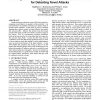Free Online Productivity Tools
i2Speak
i2Symbol
i2OCR
iTex2Img
iWeb2Print
iWeb2Shot
i2Type
iPdf2Split
iPdf2Merge
i2Bopomofo
i2Arabic
i2Style
i2Image
i2PDF
iLatex2Rtf
Sci2ools
KDD
2002
ACM
2002
ACM
Learning nonstationary models of normal network traffic for detecting novel attacks
Traditional intrusion detection systems (IDS) detect attacks by comparing current behavior to signatures of known attacks. One main drawback is the inability of detecting new attacks which do not have known signatures. In this paper we propose a learning algorithm that constructs models of normal behavior from attackfree network traffic. Behavior that deviates from the learned normal model signals possible novel attacks. Our IDS is unique in two respects. First, it is nonstationary, modeling probabilities based on the time since the last event rather than on average rate. This prevents alarm floods. Second, the IDS learns protocol vocabularies (at the data link through application layers) in order to detect unknown attacks that attempt to exploit implementation errors in poorly tested features of the target software. On the 1999 DARPA IDS evaluation data set [9], we detect 70 of 180 attacks (with 100 false alarms), about evenly divided between user behavioral anomalies (IP addresses a...
| Added | 30 Nov 2009 |
| Updated | 30 Nov 2009 |
| Type | Conference |
| Year | 2002 |
| Where | KDD |
| Authors | Matthew V. Mahoney, Philip K. Chan |
Comments (0)

